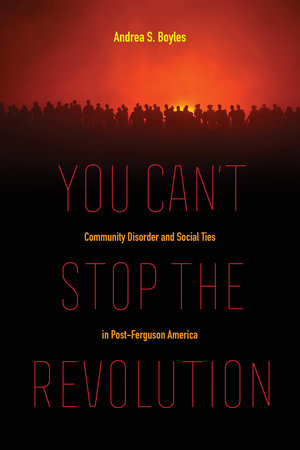By Andrea S. Boyles, author of You Can’t Stop the Revolution: Community Disorder and Social Ties in Post-Ferguson America
This guest post is part of our ASA blog series published in conjunction with the meeting of the American Sociological Association in New York City, NY, August 10-13. #ASA19
Imagine.
Saturday, August 9th, 2014. Crime tape, armored vehicles, increasing black protestors, multiple jurisdictions of police, high-powered rifles, grieving family members, witnesses, media, circling helicopters—all assembled on the first day and night of resistance in Ferguson [1]. By night’s end, and before the world could grasp this “socio-historical shift,” [2] there had already been an amalgamation of turmoil—social/physical cues or “disorder” [3] and an unprecedented move to combat its effects. This civil unrest and uprising “had been a long time coming.” [4] The ambiguous murder of Michael “Mike” Brown, Jr.—a four and a half hour, hot-pavement display of a young, unarmed dead black man—was bound to ignite a (re)birth of black consciousness and resistance.
It has been five years, but it seems like yesterday. I can still sense the deployment and gasping, ghastly effects of tear gas on citizens to recollections of pepper-sprayed eyes, streaming tears, Maalox or milk-covered faces scattered about the streets. These are the real-time sights and sounds of race and class conflict, accounted for in You Can’t Stop the Revolution. More directly, they are the special effects of community (dis)order—(re)conceptualized from a black cultural perspective—rooted in evaluations of historically systemic discrimination and state sanctioned consequences, pre- and post-Ferguson.
Intersectional plights and efforts to counter them remain intense, extending well beyond racialized policing. From grassroots organizing of indigenous nations against the Dakota Access Pipeline [5] and the humanitarian crisis at the Southern border/Global South [6], to hurricane response(s), debt, a gubernatorial resignation in Puerto Rico [7], Hong Kong’s “now suspended” extradition policy [8], and more, it is evident that “…not only did we learn, we expanded…,” [9] as once stated by a Ferguson activist-turned-elected official. The broader messaging affirms “Ferguson is everywhere” [10], and combating systemic oppression despite backlash only bears more deeply entrenched, infectious convictions and strategies for more mobilization and advancement.
Five years later, the resolve is the same. Ferguson as a pivotal socio-historical “template” [11] is ongoing, globally. Unpacking its many layers has taken all that I learned from the streets and the academe and necessitates continuing, holistic racial/ethnic contextualized analyses. That is, comprehensively nuanced examinations that match both the obstinateness of policies/practices that gave rise to Ferguson and the unyielding depth and commitment of people of color, especially those working in the trenches, as most disparaged by them and moved to rise up against them.
- Boyles, Andrea S. 2019. You Can’t Stop the Revolution: Community Disorder and Social Ties in Post-Ferguson America. Oakland: University of California Press.
- Ibid, 14-15.
- Ibid, 17.
- Sam Cooke, 1964.
- The Dakota Access Pipeline: Native American Perspective (2019). See https://libguides.unm.edu/DAPL.
- Fleeing for Our Lives: Central American Migrant Crisis (2019). See https://www.amnestyusa.org/fleeing-for-our-lives-central-american-migrant-crisis/
- Aleem, Zeeshan. 2019. Vox. See https://www.vox.com/2019/7/20/20701898/puerto-rico-protests-ricardo-rossello-resign-ricky-renuncia-text-scandal
- Griffiths, James. 2019. CNN. See https://www.cnn.com/2019/07/25/asia/hong-kong-china-2047-protests-intl-hnk/index.html
- Boyles 2019, 154.
- “Ferguson is everywhere” was a message on a box placed on the highway during the 2015 Interstate 70 shutdown in St. Louis, MO.
- Boyles 2019, 14-15.



